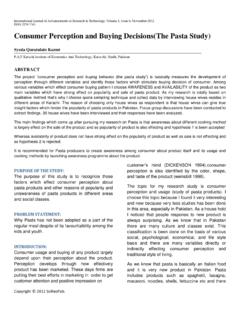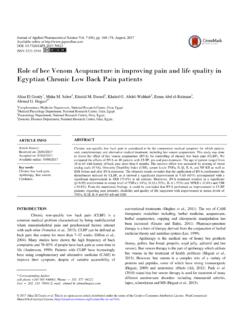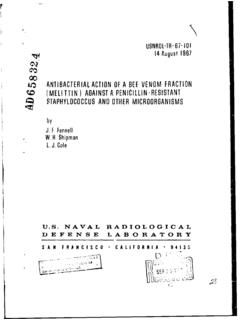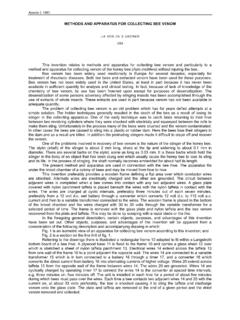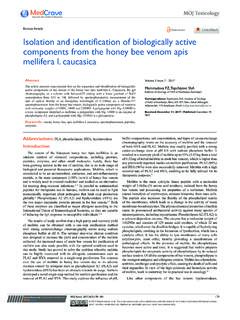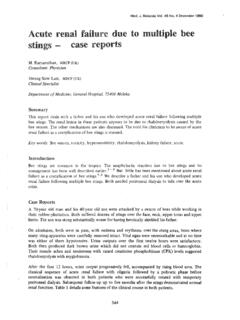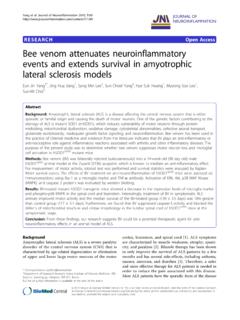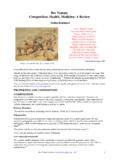Transcription of Studies on Bee Venom and Its Medical Uses - IJOART
1 International Journal of Advancements in Research & Technology, Volume 1, Issue2, July-2012 1 ISSN 2278-7763 Copyright 2012 SciResPub. Studies on Bee Venom and Its Medical uses Mahmoud Abdu Al-Samie Mohamed Ali Department of Plant Protection, Faculty of Agriculture, Ain Shams University, Cairo, Egypt. (Present Address: Honey bee Expert, Arab Organization for Agricultural Development, League of Arab States, Ministry of Agriculture, Riyadh, ). E-mail: ABSTRACT Use of honey and other bee products in human treatments traced back thousands of years and healing properties are included in many religious texts including the Veda, Bible and Quran.
2 Apitherapy is the use of honey bee products for Medical purposes, this include bee Venom , raw honey, royal jelly, pollen, propolis, and beeswax. Whereas bee Venom therapy is the use of live bee stings (or injectable Venom ) to treat various diseases such as arthritis, rheumatoid arthritis, multiple sclerosis (MS), lupus, sciatica, low back pain, and tennis elbow to name a few. It refers to any use of Venom to assist the body in healing itself. Bee Venom contains at least 18 pharmacologically active components including various enzymes, peptides and amines.
3 Sulfur is believed to be the main element in inducing the release of cortisol from the adrenal glands and in protecting the body from infections. Contact with bee Venom produces a complex cascade of reactions in the human body. The bee Venom is safe for human treatments, the median lethal dose (LD50) for an adult human is mg of Venom per kg of body weight, a person weighing 60 kg has a 50% chance of surviving injections totaling 168 mg of bee Venom . Assuming each bee injects all its Venom and no stings are quickly removed at a maximum of mg Venom per sting, 560 stings could well be lethal for such a person.
4 For a child weighing 10 kg, as little as stings could be fatal. However, most human deaths result from one or few bee stings due to allergic reactions, heart failure or suffocation from swelling around the neck or the mouth. As compare with other human diseases, accidents and other unusual cases, the bee Venom is very safe for human treatments. Keywords: honey bees, apitherapy, bee Venom , bee sting, chemical composition, physical properties, Medical uses . 1 INTRODUCTION The exact origins of apitherapy are difficult to pinpoint and can be traced back to ancient Egypt, Greece and has been practiced in China for 3-5000 years (Rose, 1994).
5 Use of honey and other bee products can be also traced back thousands of years and healing properties are included in many religious texts including the Veda, Bible and Quran [5], [6]. Now it is being practical all over the world. In the USA the history of apitherapy goes back about 100 years, it was practiced by several prominent doctors including Dr. Bodog Beck, who started treating people in his New York City office in the late 1920's. Dr. Beck's book "Bee Venom Therapy" has been classic for 60 years. The last surviving student of Dr.
6 Beck is Middlebury, Vermont beekeeper named Charles Marz, who was known by the many as the "King of bee Venom therapy". He had been practicing apithirapy for over 60 years with remarkable results, and most of his experience had been with treating arthritis, but his success was with multiple sclerosis (MS) [7]. Among the many species of insects, only very few have the capability of defending themselves with a sting and Venom injection during stinging. All insects that can sting are members of the order Hymenoptera, which includes ants, wasps and bees.
7 Since the sting is believed to have evolved from the egg-laying apparatus of the ancestral, hymenopteran species, only females can sting. The sting is always at or near the abdominal end, rather than the head. Therefore the pain inflicted by a honeybee, defending its colony, is not caused by a bite, as is frequently said, but by a sting [8]. The larger drone bees, the males, do not have stingers. The female worker bees are the only ones that can sting, and their stinger is a modified ovipositor.
8 The queen bee has a smooth stinger and can, if need be, sting skin-bearing creatures multiple times, but the queen does not leave the hive under normal conditions. Her sting is not for defense of the hive; she only uses it for dispatching rival queens, ideally before they can finish pupating [8]. Bee Venom (BV) therapy which utilizes the application of bee Venom to treat various diseases has been used since ancient times in traditional medicine [1], [2], [3], [4], [92], [101], [133]. Honey bee Venom as a well-known pharmacologically active product of the hive.
9 It is synthesized by the Venom glands associated with the sting apparatus of worker and queens, stored in the Venom reservoir, and injected through the sting apparatus during the stinging process [9], Its production increases during the first two weeks of the adult worker's life and reaches a maximum when the worker bee becomes involved in hive defense and foraging. It diminishes as the bee gets older [8]. A mature defender or forager contains about 100-150 g of Venom , and it inject mg of Venom via its stinger [10], a honeybee can inject mg of Venom via its stinger.
10 The queen bee's production of Venom is highest on emergence, probably because it must be prepared for immediate battles with other queens [8]; the young queen contains about 700 g [11]. International Journal of Advancements in Research & Technology, Volume 1, Issue2, July-2012 2 ISSN 2278-7763 Copyright 2012 SciResPub. However, BV administration was reported to stimulate the function of immune system [12] and to affect the release of cortisol production which is known as natural anti-inflammatory agent [13].

